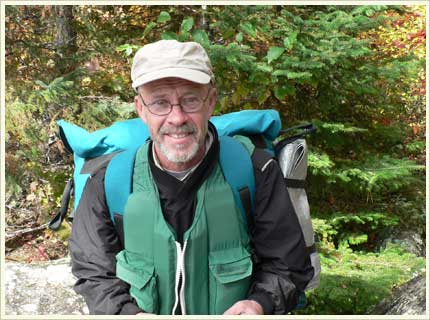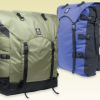Men in the Bush: An Autumn Canoe Trip
TRIP LOG: Submitted by Ken Wood, April 1, 2009
My obsession for canoe tripping is always difficult to control. It is an addiction that becomes compulsive as I get older. This past fall what started as a hopeful draw on a BWCAW moose permit turned into a classic autumn tour.
My companions were a group of five, myself, Rob Kesselring, John Diller, his son Steve, and Rich Berg. Our planned trip was a seven day leisurely loop from Little Indian Sioux entry point to Moose River where we would exit. The trip took place the last few days of September and the first few days of October 2008.
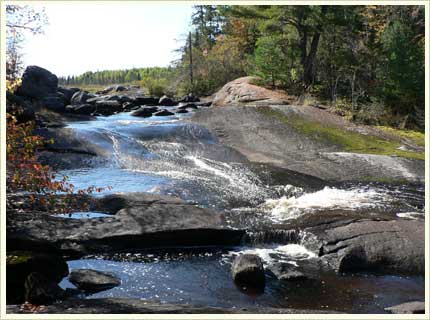
————————————————————————————-
Day 1
After receiving our permit from the U.S. Forest Service in Ely, we ate breakfast and drove out the Echo Trail to our jumping off point. It was actually a stunning drive with all the foliage almost to peak color.
Once we arrived at the parking lot we took our gear out and spread it amongst the packs. For the five of us we had a total of 2 canoes, 6 packs, 5 paddles and 1 shotgun in a waterproof case.
We were blessed on this trip with two finely crafted and well designed canoes by John Diller owner of Savage River canoes, the 18’ 6” Susquehanna, and the 16’ 6” Deep Creek. Both models are in the 30lb. class. Our outfit allowed us to carry a reasonable load across portages and one man to ride “Duffer” amidships of the Susquehanna.
Everyone changed into bush clothes, then the last minute stuffing of small articles into the portage packs and fishing poles lashed to the thwarts and off to the portage trail.
For me, the first carry is always satisfying, all things have come together, right or wrong, good or bad. It was now time to live life on completely different terms. No worries about the nitty gritty of the city. As I made this carry I felt a burden lift off of me and a quote from John Muir came to mind, “A trip to the woods is like going home”.
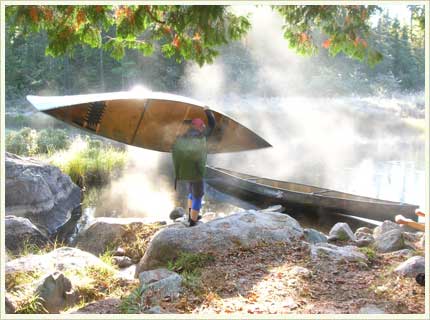
It was a stellar afternoon as we launched at the end of the portage. Everyone was excited to be here along with the bonus of sunny calm weather.
Although I wasn’t looking forward to duffing, I was the first to duff in the Susquehanna with John and Steve paddling. Actually, this was the first time I remember riding rather than paddling, it was a wonderful way to see more scenery rather than continually paddling. Before I knew it the first portage arrived, a short 65 rods. The single portage pays off. Everyone has their own piece of gear to be carried across. The canoes don’t touch the shore, you wet-foot the landing holding the canoe in knee-deep water. Packs are put on while you are in the water and the boats are flipped onto shoulders. You then make the carry to the opposite side of the portage, boats in the water first, and then the packs go directly into the canoes, grab your paddle and off you go.
Clothing for this time of year is the hardest to pack. It might be a balmy 70 degrees in the day with freezing rain at night or snow or continuous rain is also within the realm of possibilities. Cotton clothing is never a good choice especially this time of year because if it gets wet with rain or sweat it will wick away your body temperature fast. Cotton clothing takes a long time to dry out compared to modern synthetic materials. On this trip, the clothing taken into the bush was quality manufactured gear from materials like wool, polar fleece, down, Gore-Tex® or polyester.
So, in two and a half hours time we made the trip to our first camp at Devils Cascade midway across the portage trail. Our camp was on the edge of a canyon formed by the last ice age. A walk to the very edge of this chasm revealed a breathtaking vista. A small stream tumbled over a bed of boulders one hundred feet below the view with the yellow of the aspens and scarlet of the maples all showing their brilliance.
Camp was set up, firewood gathered and water was fetched to be filtered. Just then we had some visitors, a few grouse strutting through our camp. Ooh, if they only knew that one of our goals was to have a couple for dinner! As luck would have it the shotgun was still in its waterproof case and the ammunition was still packed deep within a pack. A flurry of activity erupts. Packs were dumped out and the ammo found, gun uncased, gun loaded. Then, as you might expect, the grouse had vanished!
Back to dinner with a few bratwurst cooked along with some tea over a modest sized fire. After our dinner we enjoyed a welcomed nightcap.
It was a long day for all of us traveling and getting to the BWCAW, so we turned in early after a few stories exchanged around our little fire.
————————————————————————————-
Day 2
I woke up in the morning at about 6:30. It was still dark with the sound of light rain. Actually, I didn’t want to get up as I was pleasantly toasty inside my bag. By 7:00 a.m. everyone was up and a fire was going. The water for breakfast and tea was put to boil. As the water was warming we discussed the day’s plan. The plan was to paddle the ten miles to Fat Lake. The paddle entailed a mostly northwardly direction against a cold rain, but we were prepared. It was about 35 degrees with a 15-mile an hour wind that had a raw nature to it.
As we paddled north it appeared we had an option to get to Fat Lake from Slim Lake with a small feeder creek and avoid five miles and five portages of effort. We all agreed at the end of the portage into Slim to investigate this possibility. We paddled to the feeder creek and found what looked like a trail. We landed and investigated the trail only to find it dead ends about fifty yards from Slim Lakes’ shore. This must have been an animal trail which didn’t lead to Fat Lake. It was a unanimous decision to not bushwack a new path!
We continued northward and arrived at South Lake. Somewhere along the way the weather eased to about fifty degrees with an on-and-off light drizzle.
It was decided to make camp at South Lake as we were not in a hurry and our plan was to enjoy our time. The first order of business was to get a tarp for shelter and lay in some firewood. The wood chance in this area wasn’t so good, but a quick paddle to the opposite shore allowed us to get a sufficient supply. Most of our wood supply was damp so we split most all of our supply to get to the bone-dry heartwood exposed. Soon a blaze was lit and we were all warm and dry.
With enough time left before dark John, Steven and I decided to try a little fishing. Lady Luck shined upon us as we caught several Smallmouth Bass in the 15”-18” class and John caught a nice fat 20” Smallmouth Bass which was photographed and released. It was a unanimous decision to have a fish dinner that night. Our fish dinner was accompanied with Rob’s world famous bannock “Dodgers”. After dinner was cleaned up the stories flowed about previous trails into the bush by a warm fire and good company which rounded out the day.
————————————————————————————-
Day 3
Wake up was shortly after daylight and we were ready to meet the day’s goal of making Fat Lake which we fell short of yesterday. Breakfast was quickly done while camp is being broke down. Before we all realized it we were loaded and ready to paddle. Rich and I paddled the Deep Creek and John and Steven paddle the Susquehanna while Rob rode duffer. In a few hours we arrived on Fat Lake. We had the only campsite on this splendid little lake.
Our camp had a large granite spit that afforded a shear drop off in front of our camp. The view was beyond words, at least in my mind it had been touched by our maker!
This day had the weather actually cooperating. We were fortunate at this campsite to have good wood chance. We laid in a supply of cedar. This is the preferred fuel by all woodsmen. The resinous quality of this wood makes it easy to light, splits easy and produces a hot fire.
Rob cooked a one-pot meal delicacy for dinner as the sun was setting. The temperature was rapidly falling so we enjoyed our dinner around the warmth of our fire.
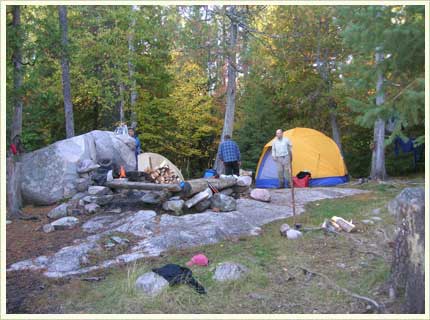
————————————————————————————-
Day 4
The next day brought more country to view. We traveled westerly from Fat Lake to Ge-be-on-e-quet Lake. This was a short hop of seven miles and seven portages. This route takes us through some small lakes and creeks. The creeks had all the elements of moose country but this day we were not to see them. Although we did see three otters in Ge-be-on-e-quet.
The weather turned to the better, so rain gear was shed, but a fleece jacket was still in order. It was around fifty degrees, sunny and comfortable.
Along the day’s carries I gathered a couple nice big pieces of birch bark off of a dead and downed birch and stuffed them in the gear pack. Even though it was not raining all of the country was wet from previous rain and the bark will make easy work of lighting the day’s campfire.
Time allowed us to fish and hunt so off we go. Rob and Rich took to the woods for grouse, while John, Steven and I took to the lake for fishing.
We have only seen one other group on this trip which was on our first day and they were portaging out. The fall colors were in prime opulence adding to the feeling that for this brief time the woods were ours alone.
The fishermen returned again after some sporting catch-and-release of Smallmouth Bass and some Northern Pike on light spinning tackle, then the hunters returned with stories of missed opportunities. We did have fun with the bantering.
After dinner and darkness we retired to the “Pleasure Dome” for some spirited card games. The Pleasure Dome was a large four-man dome style tent. This afforded us several options. First, lots of room for three people and gear. Most important though was a lamp which hung inside to create a nice warm, dry place for card games. So, this night I was royally and soundly whipped at cards, enough said on that subject!
————————————————————————————-
Day 5
Next morning we were off to Oyster Lake. This was a leisurely four maybe five miles and three portages. Here we planned to spend two nights. Today’s weather was the best so far, sunny, clear and warming up quickly.
We camped on a peninsula that was maybe only a hundred yards wide. Camp was in order in the blink of an eye. This afternoon’s itinerary was to just relax and take it all in.
We decided that the next day John, Steven and I would paddle to Lac la Croix to view Warrior Hill and the fine example of pictographs just north of Warrior Hill. Rob and Rich would hunt the Sioux Hustler trial for some yet to be had grouse.
————————————————————————————-
Day 6
Morning came with frost and thick convection fog blanketing the entire lake. We watched this fog being slowly swept off the lake as the sun rose. Even though I have seen this many times it remains a sight to behold.
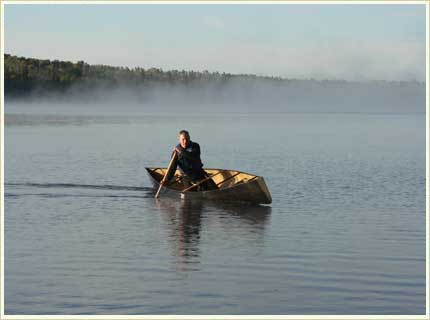
It was about a seven mile paddle from our camp at Oyster Lake to Lac la Croix.
A couple of portages and a rare flat, calm, sunny day brought Warrior Hill to view, then a short paddle to what could be argued as the finest pictographs on the Canadian Shield. No matter how many times these are viewed they remain awe inspiring. How old, what do they mean, we can only surmise. So we took pictures and exchanged the who, when and why’s . We then paddled the short distance to the sand beach to the north for lunch, bathed in the warm sunshine and made the return trip to Oyster Lake.
Once we got back to Oyster Lake we found the hunters rejoicing as we will be having grouse for dinner! We were happy for them knowing they put in a real effort for us to have this delicacy.
The grouse were cubed and braised in a skillet then added to a hearty soup. The soup along with more world famous Dodgers made a filling, delicious dinner. Over dinner we shared stories of the pictographs and the hunters’ trip to the Sioux Hustler trail. Rob and Rich shared that the trail around Oyster Lake is not well traveled. They said it would be easy for a beginning hiker to lose the trail and become flustered. It would be easy to be in for a longer stay in the wilderness than one bargained for!
It must have been very close to freezing and we were privy to a very clear starlit night. We all went to the waters’ edge and viewed this spectacular sight, seeing several satellites zooming across the sky.
By then it must have been close to 10 p.m. and the highlight of the trip occured. As if on cue, as we were contemplating going to bed, a pack of wolves started to howl. I have heard wolves many times over the years, almost always they send chills down my spine and stand the hair up on the back of my neck.
I always consider it a plus to hear them, but this pack must have had a kill on the peninsula right behind where we were camped. They were very close to say the least! We picked out at least seven distinct different howls. They continued to howl for about fifteen minutes time. As suddenly as they started it just stopped. In all my years this was by far the closest and most exhilarating display of howling I had been witness to, simply put, primal and awesome!
————————————————————————————-
Day 7
Last morning, up at daylight with convection fog, frost and skim ice. The lake was really giving up some heat, a sure sign of winter on the doorstep. The trip from Oyster Lake to Nina Moose entry was eight miles and seven portages.
We had breakfast and broke down camp. We were fortunate that all of our gear was dry as we packed. The lake temperature was close to freezing so the gunnels were well out of the water to prevent getting wet.
Once all of the gear was loaded we checked our route through the Oyster River to Nina Moose River, then to Nina Moose Lake and back to the Moose River.
This was a captivating stretch of waterway winding through breathtaking country. This stretch offered swamps, cliffs, huge rocks, lakes, portages and beaver dams. As we made the paddle prime fall colors were now showing.
We dragged our canoes over at least half a dozen beaver dams and arrived to Nina Moose Lake for a quick snack. From this point on Nina Moose Lake was an hour paddle to our take-out portage then on to our vehicle.
A hearty handshake and pleasant good byes to my friends, as we then parted company, ‘till another trip! All of this was now a pleasant memory!
